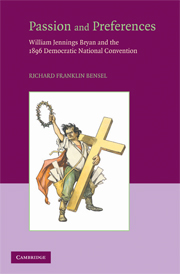6 - Display of Passion
Published online by Cambridge University Press: 24 July 2009
Summary
In very formal settings, displays of passion are strongly constrained by ritual proprieties. Roll calls in a convention, for example, are thoroughly structured by parliamentary rules. These rules identify who can vote, when they can vote, and what will be the relative weight assigned to their vote. Once delegates have voted, the rules apply an exact calculus that determines the outcome. In other settings, people display sentiment much more spontaneously, as in the collective displays created by mass demonstrations and riots. Such displays are not formally recognized or structured by an institution. For convenience, let us agree to call displays of sentiment that are strongly constrained by formal ritual institutionally recognized preferences and label displays that lay outside institutional forms demonstrative acts.
Institutionally recognized preferences are usually “flat” in that the way in which an individual or group displays sentiment does not affect the manner in which the institution calculates the outcome. For example, in a legislative roll call members may stand perfectly still or wildly gesticulate as they cast their vote. However they cast their vote, the calculus will treat it as the same act. There are thus three characteristics associated with the display of institutionally recognized preferences: they are strongly constrained by ritual formalities; they enter into a calculus that processes them into a collectively recognized decision; and the intensity with which they are displayed has no effect on how the calculus processes the response.
- Type
- Chapter
- Information
- Passion and PreferencesWilliam Jennings Bryan and the 1896 Democratic Convention, pp. 159 - 202Publisher: Cambridge University PressPrint publication year: 2008



